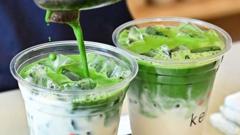The matcha phenomenon is taking the world by storm. The vibrant green Japanese tea is now featured in various products, from Starbucks' beverages in the UK to Krispy Kreme doughnuts in Singapore. This surge in popularity is closely tied to social media, where influencers share brewing techniques, product reviews, and recipes. The hashtag "Matcha Tok" has garnered millions of views, showcasing the tea's growing influence.
The increase in matcha's global presence is also attributed to Japan's post-pandemic tourism recovery. The country's weak currency has made it an appealing travel destination, driving the desire for Japanese products. In the face of this trend, demand for matcha is spiking significantly. Lauren Purvis, a tea importer from the US, notes that customers are experiencing rapid depletion of supplies, with some cafes requesting up to a kilo daily to satisfy their patrons.
This surge in demand, however, coincides with diminished tea crop yields caused by extreme heatwaves and import tariffs imposed by the US on Japanese goods, which together are pushing matcha prices higher. Traditionally, matcha is produced from tencha leaves, which undergo a meticulous shading process to develop their signature flavor. The leaves, harvested and milled, yield only a small amount of matcha per hour.
Recently, farmers have encountered difficulties as record-breaking temperatures adversely affect harvest yields. In Kyoto, known for producing about 25% of Japan's tencha, the unfavorable climate has resulted in inadequate crops. Furthermore, the aging farmer population poses a challenge for traditional tea cultivation, with fewer young individuals entering the industry.
Tourist appetites have left stores in Uji, a city famous for matcha, with empty shelves shortly after opening. In light of this scarcity, several retailers now restrict purchases to a single tin per customer, as stated by Atsuko Mori, director of a local tea ceremony establishment. Tea ceremonies which customarily feature matcha now face 30% price hikes due to these shortages.
Despite challenges, the increasing interest in matcha presents an opportunity for cultural promotion, according to Rie Takeda, a tea master at a Tokyo-based chain. The Japanese agricultural ministry reports that matcha production has nearly tripled from 2010 to 2023, with green tea exports, including matcha, rising by 25% last year to approximately 36.4 billion yen (around $250 million).
The heightened demand has prompted a campaign for mindful consumption to discourage consumers from hoarding matcha or minimizing its value through excessive cooking. Advocates like Ms. Mori lament the use of high-grade matcha in less sensitive applications, urging tea drinkers to appreciate its intricate flavors in their purest form. The Global Japanese Tea Association recommends that individuals consider using lower-grade matcha from later harvests, which are more plentiful and suitable for culinary uses.
Continued tariffs on Japanese goods threaten further price hikes, especially since the recent US-Tokyo trade deal imposed a 15% import tax on Japanese products. Matcha suppliers are preparing for these changes, with Purvis highlighting a 70% increase in orders ahead of the tariff agreement deadline.
Long-term projections suggest that while demand remains strong, it may stabilize in the coming years. Masahiro Nagata, co-founder of the Matcha Tokyo chain, believes current high prices for lower-quality matcha will not be sustainable. He predicts a cooling of the matcha trend, allowing for a more balanced market in two to three years.




















